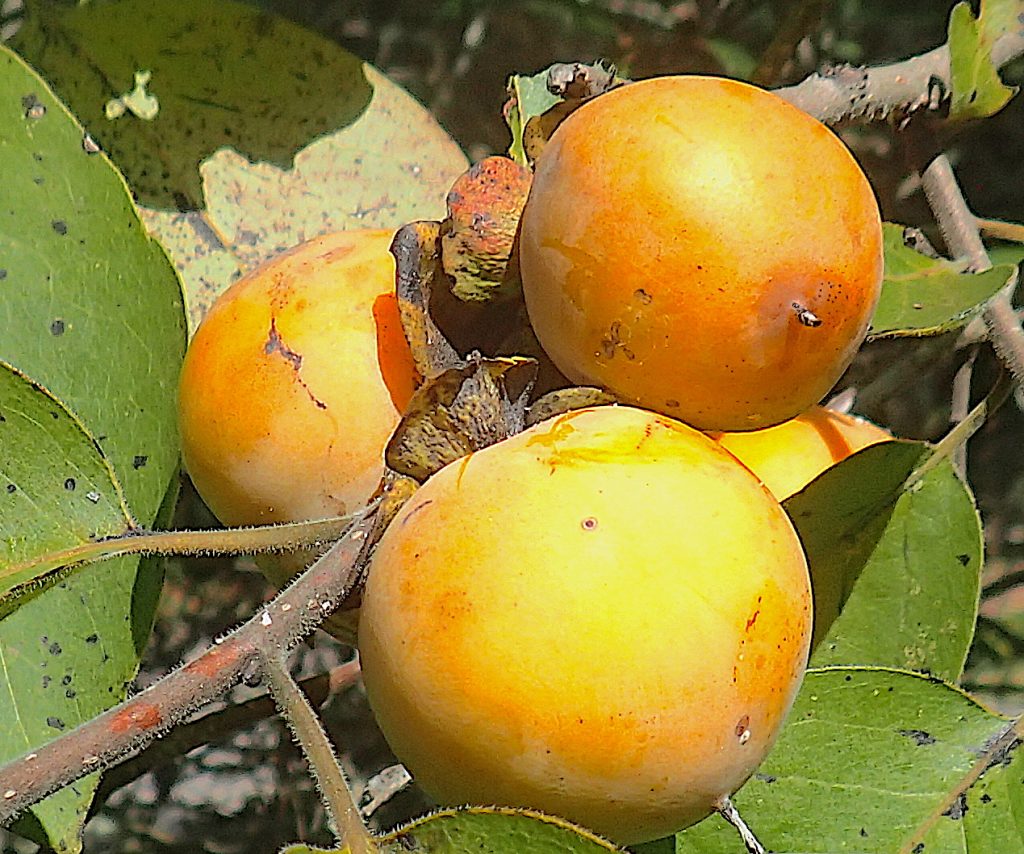
The best persimmons are the ones you have to fight the ants for. Photo by Green Deane
In nature close is often good enough. Locally we expect grapes to ripen about the first of September but they can show up in late July or early November. This year the persimmons seems to be late. Usually some are ripe by early October. I saw trees Monday that still had green fruit on them. I think the latest I’ve found edible persimmons is early January. The timing is also way off for the Pineapple Guava.
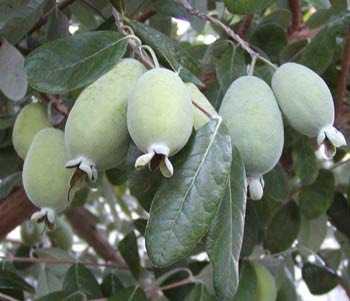
Ripe and unripe Pineapple Guava looks the same. Photo by Green Deane
Usually in early September the green fruit, left, softens to edible. It is now past mid-October and the fruit is still hard. Does that mean a late-lasting winter so to provide creatures with food later in the season? And Saturday in Sarasota we saw Pellitory. It’s a winter annual that usually becomes noticeable in late November. We saw and sampled six-inch high plants. So far the ringless honey mushrooms have not flushed. Locally they are usually pushing up near Veteran’s Day in November. Wintertime foraging varies where you live. In moderate Florida we can forage all year and the wintertime provides some of the best opportunities. But what of northern climates?
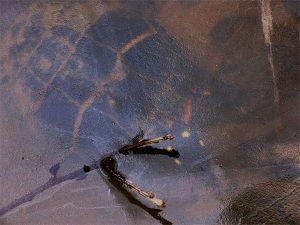
An edible turtle under ice. Photo by Richard Due.
I grew up where winter night temperatures easily dropped into the 30-plus below zero (-40 celsius.) Sometimes the schools had to close for several days because they could not be kept warm or there was too much snow to plow the roads. And once we went skating at 50 below just to say we did. (Chilblains from that night some 60 years ago still bother me in air conditioned buildings. It’s wasn’t the skating with a bonfire that did permanent damage but rather the arctic one-mile walk from and to home.) We did that skating on Gowen’s Pond, our local natural skating rink. It had one tree-stump island which probably had been a water-tolerant hackmatack. That speck of protrusion through the ice was perhaps six square feet in total area. The ice was thinner there and one winter I saw a turtle under the ice feeding some some green pond plant. That generated several thoughts. One was that it was warm enough for the turtle to go looking for food. Two, that the turtle found food, and, three, that the turtle was food even in the winter. Like the turtle or deer or the horses I grew up with you can find food in hostile winter climates if you know where to dig or browse. You can read more about wintertime foraging here.

Monstera does not want to be eaten until the right time. Photo by Green Deane
Fall is a good time to look for Yellow Pond Lilys. While they fruit rather continuously these pond residents are putting forth a crop now. Plants may not have a brain they can have a strategy, or at least so it seems. Many of them protect their seeds in various ways until they are ready to germinate. The Persimmon Tree above comes to mind. The fruit is astringent until the seeds are mature enough to germinate. Then the fruit turns sweet attracting various animals to eat it — those that can taste sweet — and spread the seeds around. The Monstera deliciosa , left, has the same sugar strategy. The seeds are acrid until ready to germinate then they turn sweet. They have a flavor reminiscent of pineapple and/or wild chamomile. The Yellow Pond Lily works in a similar fashion, almost. It does not turn sweet but the bitterness goes away. Seeds that are not ready to germinate are bitter. As the plant dies the floating seed pod rots over a three-week period. When the seeds are ready to germinate the protective bitterness is removed by enzymatic action. This also makes the seeds edible. Of course we humans can take advantage of the system by collecting the seed pods ourselves and controlling the rotting process. Then we get the seeds and dry them for use in various ways. You can read more about the Yellow Pond Lily here.
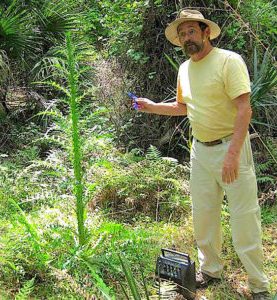
Foraging classes are held rain or shine, heat or cold. Photo by Nermina Krenata
Foraging Classes: Making a foraging loop this weekend around south Florida with a class in West Palm Beach Saturday and Port Charlotte Sunday. Might so some fishing in one place or the other or both.
Saturday October 23rd, Dreher Park, 1200 Southern Blvd., West Palm Beach, 33405. 9 a.m. to noon, meet just north of the science center.
Sunday October 24th, Bayshore Live Oak Park, Bayshore Drive. Port Charlotte. 9 a.m. to noon, meet at the parking lot of Bayshore and Ganyard.
Saturday November 6th, Boulware Springs Park, 3420 SE 15th St., Gainesville, FL 32641. Meet at the picnic tables next to the pump house. 9 a.m. to noon.
Sunday November 7th, Blanchard Park, 10501 Jay Blanchard Trail, Orlando, FL 32817. 9 a.m. to noon, meet by the tennis courts.
For more information, to pre-pay or sign up go here.
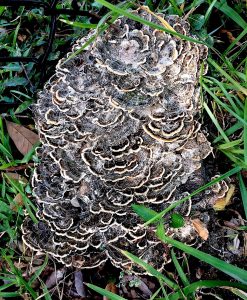
True Turkey Tails. Photo by Green Deane
Turkey Tails are a fairly easy-to-identify medicinal mushroom. For a common type of mushroom I don’t see them that often… two or three times a year. I see False Turkey Tails far more often. More on that later. A seven-year study funded by the National Institutes of Health found Turkey Tail (Trametes versicolor) boosted the immunity in women who had been treated for breast cancer. Researchers at the University of Minnesota and Bastyr University conducted the study in women with stages I-III breast cancer who had completed radiation therapy or chemotherapy. Results showed that immune function was enhanced in the women who took daily doses of Turkey Tail in pill form. They reported that the improved immune response was dose dependent and that none of the subjects suffered any adverse effects. Trametes versicolor can be chewed whole, eaten ground, or made into a tea, or a tincture. The question that always follows such comments is are False Turkey Tails, Stereum ostrea, medicinal? Informally one hears herbalists saying False Turkey Tails can be used but there are few specifics though they have a long herbalism history. A study in 2007 found that water extracts of Stereum ostrea were antibacterial and antifungal. That’s not cancer fighting or immune system stimulating but useful nonetheless. You can read that article here.
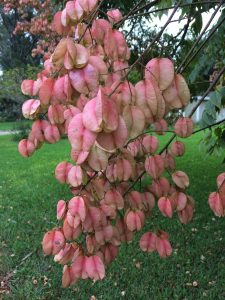
Easy to identify, difficult to remember, the Golden Rain Tree. Photo by Green Deane
And now the Golden Rain Tree… of all the species I have written about over the years this is one I have perhaps the least personal experience with. I have a good reason: I always recognize it at the wrong time of the year when it’s sporting pink seed pods. It is the tree’s springtime boiled shoots that are the most edible part of this species. In the spring, however, the tree is a rather drab Elm/Chinaberry-lookalike. Inside the pink boxy seed pods one usually finds two or four black seeds that are reportedly edible. The problem is they have unrefined erucic acid (oil) which is the same irritating oil in unprocessed rape seed oil which when idustrially processed is called Canola. If you have an undisciplined memory like mind the mentioning of erucic acid makes you think of a movie you did not see: Lorenzo’s Oil. The oil, now made from olive oil and erucic aicd, is used to treat ALD, adrenoleukodystrophy. The 1992 movie was based on the true story of parents looking for a treatment for their son. ALD is a genetic disease that causes a metabolic error that in time reduces cognitive function by making an excessive amount of a very-long-chain fat (cerotic acid.) Consumption of the man-made oil can moderate that. Lorenzo himself died of pneumonia in 2008 at age 30.) The seeds I never get around to working with are peppery — Ma Nature is giving us a warning there — and do have a small amount of cyanide. You can read about the Koelreuteria paniculata here.
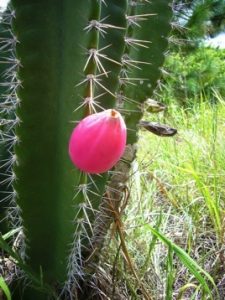
Cereus cactus fruit is wild Dragon Fruit. Photo by Green Deane
Also fruiting now are Cereus cactus. Like grapes Cereus are fairly easy to identify by genus but exactly what species is a challenge. Frankly it is a challenge one does not have to accept. Most Cereus cactus, except perhaps the commercial “Dragon Fruit” are shaped like small pink footballs about four inches long. They are attached rather strongly so nippers or the like are best to cut them off. Toss the fruit in the refrigerator for a while then cut them open like two little row boats. The white flesh has the texture of overripe watermelon. The black seeds are soft and edible (unlike most cactus seeds which are extremely hard.) The cactus themselves are called “candle” cactus as they are usually but not always an unbranching trunk. Also called Peruvian Cactus the headache associated with species identification is that there are a lot of “fake” botanical names made up by sellers. Another problem that can make cactus tough plants to identify is having to resort to counting spines and length. You can read more about them here.

Green Deane videos are now available on a USB.
My nine-DVD set of 135 videos has been phased out and replaced by a 150-video USB. The USB videos are the same videos I have on You Tube. Some people like to have their own copy. The USB videos have to be copied to your computer to play. If you want to order the USB go to the DVD/USB order button on the top right of this page or click here. That will take you to an order form. I’d like to thank all of you who ordered the DVD set over the years which required me to burn over 5,000 DVDs individually.

Green Deane Forum
Want to identify a plant? Perhaps you’re looking for a foraging reference? You might have a UFO, an Unidentified Flowering Object, you want identified. On the Green Deane Forum we — including Green Deane and others from around the world — chat about foraging all year. And it’s not just about warm-weather plants or just North American flora. Many nations share common weeds so there’s a lot to talk. There’s also more than weeds. The reference section has information for foraging around the world. There are also articles on food preservation, and forgotten skills from making bows to fermenting food.
This is my weekly free newsletter #478. If you want to subscribe to this free newsletter you can find the sign-up form in the menu at the top of the page.
To donate to the Green Deane Newsletter click here.

